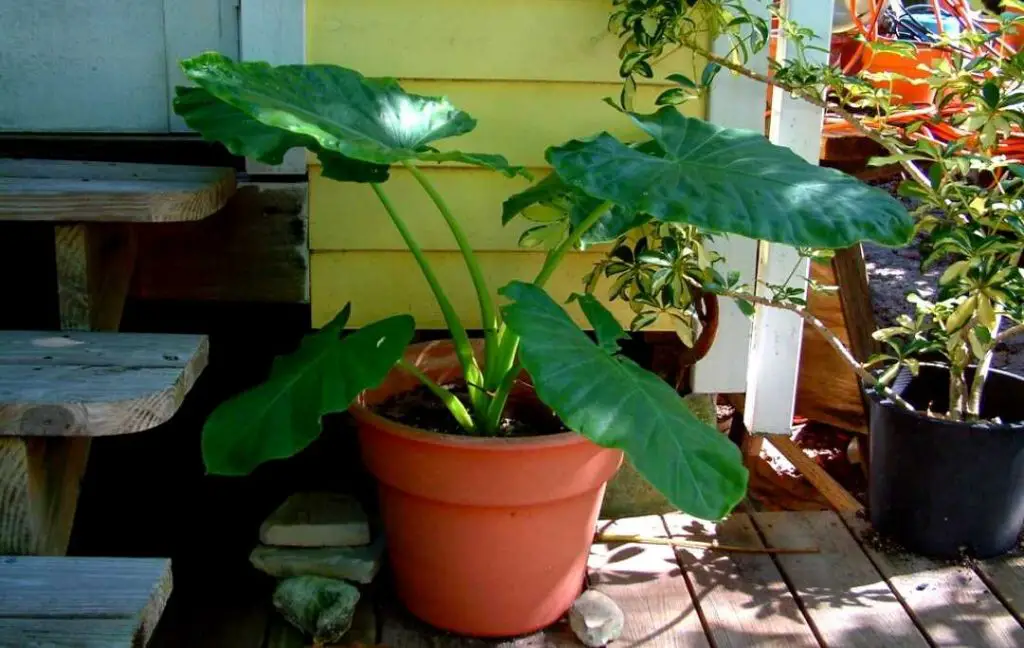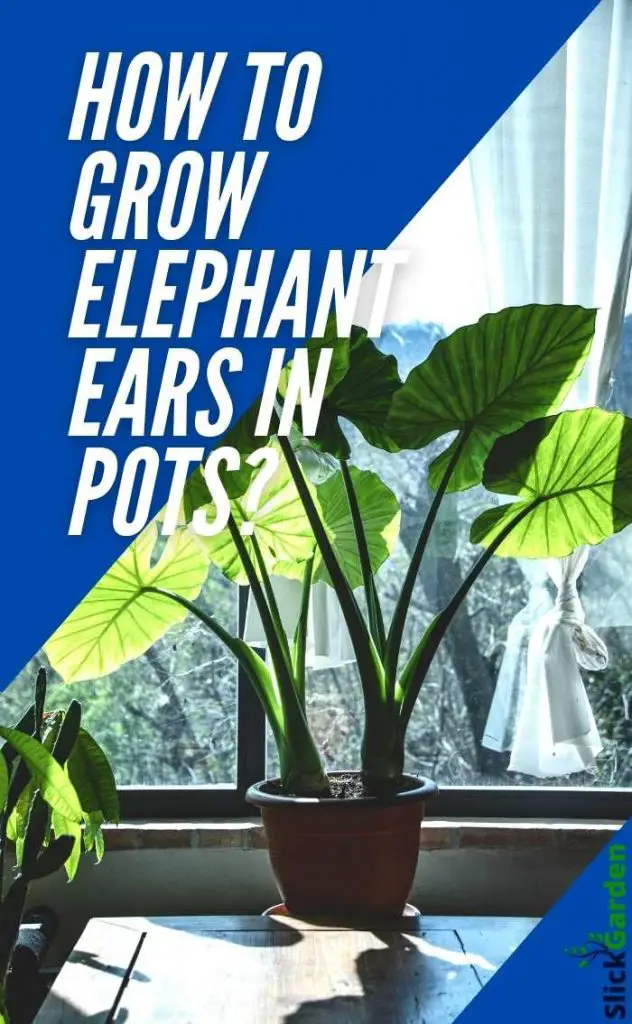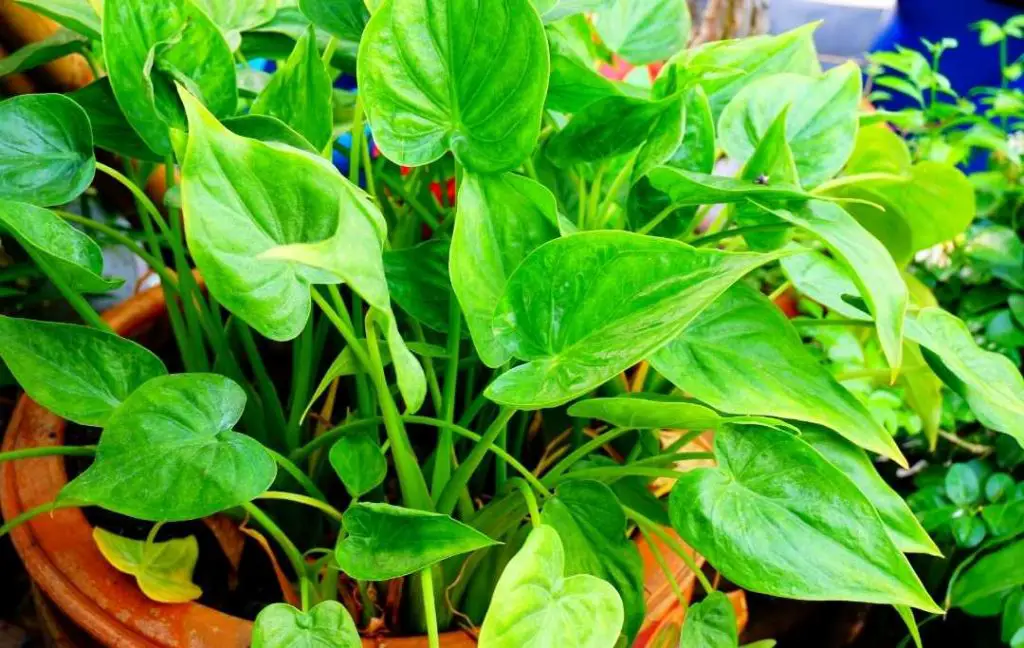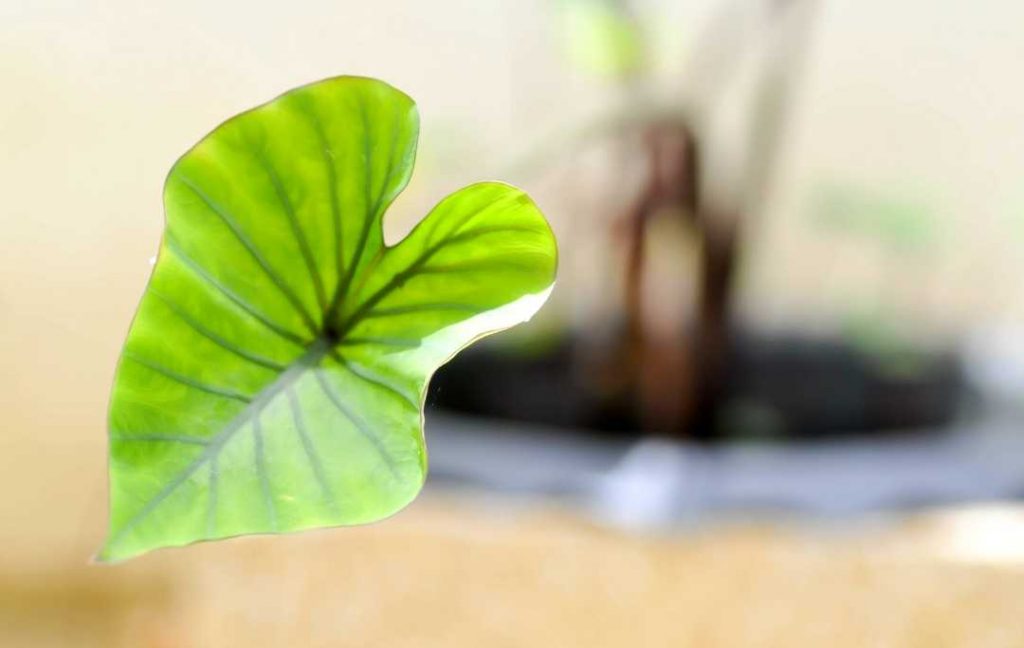This plant will change the look of your patio, garden, or living area. This name is given due to the large leaves of this plant. The size of the leaves can be several feet wide.
The leaves of this plant are found in different and beautiful colors such as lime green, dark green, and purple. If you don’t have a large growing area then you can elephant ears in pots or containers.
As this plant is large you should select a large container or a pot for growing it. You should supply plenty of nutrients because this plant has large leaves. You should select a sunny spot for your pot because in case of insufficient sunlight it will result in the death of the plant.

This summer loving plant belongs to the groups of plants, Colocasia and Alocasia. Both types of plants can be grown in your garden or as a houseplant.
Remember colocasia is the larger variety that’s why it is most suitable for growing outdoors. Alocasia can be grown as a houseplant easily.
How To Grow Elephant Plants In Pots Or Containers?
You can start elephant ears with a plant or a bulb. If you are growing in a container or pot then it is suggested to place a large stone in the bottom of the container for weight. The following are the simple and easy steps for growing an elephant ear plant in a pot or container.
Step 1: Choose The Best Size Of The Pot Or Container For Growing Elephant Ear Plant
The size of this plant is massive, which means you have to use the large size of the container. The size and the shape of the container are also dependent upon the variety you are growing.
The diameter of the pot should be 36 inches. If you don’t have a large pot for you want to grow it in a smaller planter then select the pot which is larger than the nursery pot.
If you plant elephant ears in a smaller pot then there is a need to increase the size of the container by at least 2 inches every one to two years. If you don’t want to divide the plant then divide the plant.
The division is a process in which you have to dig up the roots of the plant and break the plant into many sections at the root. Make sure each section has at least one green shoot. Now you can plant the section in different pots. Select the pot according to the size of the section of the plant.
Step 2: From Which Material The Pot Made Of
This plant is a heavy drinker so it needs a lot of water. When you grow it in containers then it will be prone to drying out when using porous material. If you select non-porous metal or glazed ceramic planters or plastic pots or containers for this plant then the evaporation process will become slow.
If you use porous material such as terracotta and wood then you have to increase the frequency of water for the elephant ear plant. Elephant plants prefer wet soil but it doesn’t mean that you can use the container without drainage holes.
If you use a container that has no drainage holes then the potting soil gets waterlogged which will result in root rot.
Step 3: Fill The Container With The Soil
When you use containers or pots for growing plants then you can maintain the fertility of soil very easily. It is not possible when you grow plants in the ground.
It is suggested that you should not take soil from the garden to fill up your containers. The soil of the garden is very compact and it will introduce bacteria and pests to your newly planted plants.
The best soil for your container is political oil, it is designed especially for containers or pots. The vermiculite and perlite present in the soil encourage proper drainage.
After filling the container with the potting soil you can also add compost to provide more nutrients for the vigorous growth of your plant.
For increasing the nutrients in the soil you can also apply a slow-release fertilizer at the start of the growing season. The elephant ear is a heavy feeder plant. That’s why you should add organic material so your soil gets all the basic requirements.
Step 4: Plant Elephant Ear In The Prepared Pot
Now your part is already for planting elephant ears. You can start your plant by transplanting seedlings or bulbs. You can also buy the plant from any local nursery and transplant it into a larger pot which you prepared for this purpose.

Read More
- How To Care For Ferns Outdoors?
- How To Care For Succulents Outdoor?
- How To Care For Indoor Spider Plants?
How To Care For Your Elephant Plant?

Elephant plants are heavy feeders and drinkers but they are very low maintenance plants. They are very suitable for container gardening. Here are some tips and instructions which you have to follow for growing them in pots or containers.
WATER OFTEN
When you plant elephant ears in the container then you should increase the frequency of water for these plants because they need a lot of water. This plant has larger leaves that’s why they need a lot of moisture.
If you do not provide water regularly, the plant will die. In pots or containers, the soil will dry faster. That’s why you should check on the soil whenever you feel it is dry then water your plants.
On hot days due to the heat of the sun, your plants need more water. So you should increase the frequency of the water due to the quick evaporation process. Make sure the plants get at least two to three inches of water every week.
FERTILIZE OFTEN
This plant grows rapidly and requires plenty of nutrients. You should apply fertilizer so the soil gets the proper amount of major nutrients for its growth. It is suggested that you should fertilize your elephant ear plant every few weeks. This will make your soil rich and full of nutrients.
OVERWINTER YOUR ELEPHANT EARS
It is not an easy task to grow elephant ears as an outside perennial plant. You can’t leave them outside Especially when you are living in a cold climate.
Bring all the courts or containers inside your home so they will be safe from the cold. In the winter, you can deal with elephant ears in two ways.
- The first option is very simple and easy. You have to cut off the older leaves and bring your pots or containers inside your home as a houseplant. This should be done before the temperature drops.
- In the second method, you should leave the foliage to die back naturally. As the temperature starts dropping then dig the bulb up. This should be done after the first frost. Now store the bulb in a cool and dry place. When spring comes then plant it in your desired pot or container. If you are using an old pot, wash it before planting.
HUMIDITY AND TEMPERATURE
This plant loves to grow in warm areas. The best temperature of growing elephant ears is between 65 to 75 Fahrenheit.
Consistent temperature is very important so you should choose a warm and sunny place for this lovely plant. If you are growing elephant ears as a houseplant then you can maintain humidity.
This plant needs a high level of humidity. You should follow the following tips for maintaining the humidity in your household environment.
- You can use a humidifier in the room where you place your elephant ear plant.
- For increasing the humidity level you can put a bowl of water and pebbles near the elephant ears plant. All the household plants can benefit from this bowl of water.
- Take a tray or the saucer and put the rocks or pebbles in it. Place your pot or container on the top of the stones.
PESTS AND DISEASES
Pests and viruses are very harmful to the growth of elephant care. If you see the dark patterns or ring spots on the leaves of this plant it means your plant has become the victim of the dasheen mosaic virus.
The development of the plant will be stopped after the attack of this virus. Aphids are responsible for spreading this virus in your plant. If you want to protect your plant from this virus then you should control the population of aphids. The other option is removing the affected plant.
Some pathogens are responsible for the root rot in elephant ears. If you use well-drained soils, your plant will be protected from this threat.
Pot or container must have drainage holes at the bottom so the extra water will drain from the soil. The solution of insecticidal soap is the best remedy against aphids and mealybugs.
Elephant ears can’t tolerate frost, need regular water and full sun. This is a prolific plant whose leaves grow very fast.
This plant doesn’t like wet feet. The wet soil becomes the reason for many diseases. The following are the clear symptoms that your plant is affected by diseases.
- The deficiency of the macro-nutrients will result in stunted leaves.
- The deficiency of micronutrients will result in pale leaves.
- If you see the stippled leaves then it shows the presence of spider mites.
- The curling leaves shows that your plant is facing the problem of a shortage of water.
- If you see the spots on the stems for the roots it means the plant is getting too much water.
Fungal leaf blight is the most common disease which affects your elephant ear plant. The clear symptoms of this disease are tiny round lesions on large leaves. This will turn the leaves into purple or yellow color and finally the leaves will dry soon.
How To Treat Sick Elephant Ears?

Copper fungicides work best against fungal diseases. When your plants are 4 weeks old you can spray on the affected plants to fight against diseases. You can apply this fungus side weekly in rainy weather.
In the dry season, twice the application of this fungicide works best. Avoid overwatering because it will prevent your plants from consistently wet leaves.
Use pure water for irrigation so you can prevent your plant from pythium rot. Your plant can’t recover easily after infection. The seedlings of this plant can easily be affected.
High humidity and extreme temperature is the reason for most diseases. Provide the best ventilation to the plants so they get fresh air for breathing. Water your plants when they need to avoid most of the diseases.
Read More
